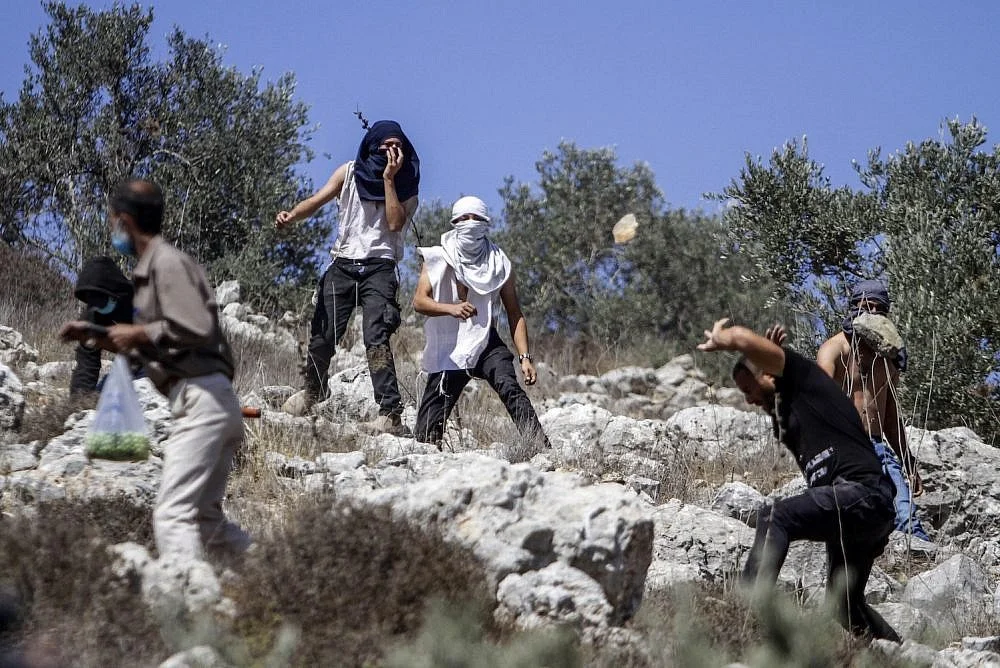The Palestinians’ Sumud in The West Bank – Once You Leave, Return is Out of The Question
Israeli soldiers stand by as masked Israeli settlers throw stones at Palestinian protesters during a demonstration against the construction of an Israeli outpost near the Palestinian village of Turmusaya and the settlement of Shilo, north of Ramallah. Source: AFP (https://www.tbsnews.net/world/us-slaps-sanctions-entities-raised-funds-west-bank-settlers-831906)
by: Selina Engelberth, Bonn International Centre for Conflict Studies
With the ongoing war in Gaza, the displacement of millions and overwhelming human suffering, it is understandable that attention is focused on the narrow coastal strip. However, in the shadow of Gaza, significant displacements are also occurring in the West Bank. Once displaced, Palestinians face no possibility of return and their sumud – steadfastness in the face of expulsion – remains remarkably high.
Since the 1967 War, Israel has occupied the Palestinian Territories – Gaza and the West Bank, including East Jerusalem. Israeli claims to these territories and its partial de facto annexation have never been recognised by the EU, which maintains that only negotiations between the conflict parties can result in new borders. However, on 19 July 2024, the International Court of Justice (ICJ) published an advisory opinion stating that:
“The sustained abuse by Israel of its position as an occupying Power, through annexation and an assertion of permanent control over the Occupied Palestinian Territory and continued frustration of the right of the Palestinian people to self-determination, violates fundamental principles of international law and renders Israel’s presence in the Occupied Palestinian Territory unlawful.” (p. 16)
The ICJ also explicitly addressed the forced displacement of Palestinians in the West Bank, citing “large-scale confiscation of land and the deprivation of access to natural resources [which] divest the local population of their basic means of subsistence, thus inducing their departure” (p. 12) as well as “Israel’s systematic failure to prevent or to punish attacks by settlers against the life or bodily integrity of Palestinians” (p. 13).
Since 1967, the settler population in the West Bank has steadily increased. In 2022, 478,600 settlers resided in the West Bank and an additional 233,900 in East Jerusalem (as of 2020). The number of West Bank settlers is expected to exceed 600,000 before 2030. To expand Israeli settlements, Palestinians must be evicted from their lands.
Two primary methods are used for land acquisition. The first method involves official state actions that are embedded in the Israeli legal system and often do not align with international law. Private Palestinian land can be confiscated for “military needs”, with the claim that settlements serve security purposes. However, civilian settlements have often been built on land taken for alleged military purposes. This method has also been used extensively for the construction of Israel’s separation barrier and closing off “special security areas” around settlements. The most common mechanism is to declare private Palestinian land as “state land”, allowing the Israeli state to legitimise de facto confiscation within its legal system. Of this “state land”, 98.8% is allocated to Israelis.
Israeli settlers hurl stones at Palestinians during the annual harvest season near the Israeli settlement of Yitzhar, Source: Nasser Ishtayeh/Flash90 (https://www.972mag.com/settler-violence-tawamin-west-bank/)
The second method involves unofficial measures, such as violence against Palestinians and the destruction of their properties, often attributed to settlers. In reality, both official and unofficial tracks are pursued by the Israeli state to acquire more Jewish-only territory. According to B'Tselem,
“Settler violence against Palestinians serves as a major informal tool at the hands of the state to take over more and more West Bank land. The state fully supports and assists these acts of violence, and its agents sometimes participate in them directly.” (p. 6)
These methods work in tandem to achieve the common goal of land seizure. Since October 7, 2023, 1,345 Palestinian structures, primarily in Area C and East Jerusalem, have been demolished, displacing 3,005 people. Israeli officials often cite missing building permits as justification, but between 2016 and 2021, 99% of the Palestinian building permit applications in Area C were rejected, with only 24 permits granted to a population of more than 300,000.
The rise of the far-right Israeli government in late 2022 has further empowered settlers, who now hold ministerial positions. The first half of 2023 saw a significant increase in settlement promotions and billions of shekels allocated for West Bank settlements and infrastructure.
In 2023, the West Bank settler population increased from 502,991 to 517,407 and is expected to exceed 600,000 before 2030. The legal annexation of the West Bank in early 2023 and the Israeli government’s recent assumption of the Palestinian Authority’s responsibilities in Area B are paving the way for more displacements and land grabs.
Since October 7, 2023, settlers have increasingly taken control of large parts of Area C, building outposts and roads and restricting Palestinian movement. The number of “state land” declarations in 2024 far exceeds that of the last 25 years. Settlement expansion in East Jerusalem has also accelerated. Settler violence has sharply increased, sometimes forcing Palestinians to flee their homes under threat of death. The government has supported these settlers with millions of shekels.
Many settlers now appear as soldiers in military uniforms, armed with military-grade weapons or serving as reservists in the IDF’s regional defence battalions. Consequently, violence involving IDF soldiers targeting Palestinian civilians has reached an all-time high, including the killing of unarmed Palestinians during riots. Since October 7, 2023, 513 Palestinians have been killed in the West Bank, which has seen the highest death rates in years under the current Israeli government.
Despite this violence, fleeing is not an ordinary reaction of Palestinians who are well aware that leaving their land means never returning. The term sumud, meaning steadfastness in Arabic, represents the non-violent resistance against Israeli occupation and ethnic cleansing, embodying the struggle to remain on Palestinian land. However, the increasing violence and destruction leave many with no choice but to leave. As a resident of Khirbet Zanuta in the South Hebron Hills described:
“I felt the presence of death so tangibly as if I saw it with my own eyes. I was torn between staying in or leaving the place I love, where I belong, where I may die. On 28 October, I made the hardest decision in my life: to leave Zanuta and leave everything behind, as memories. I did this to protect my children.” (OCHA)
In the shadow of Gaza, Israeli settlers, armed forces and the government are working together to break the Palestinians’ sumud in the West Bank. Once they have left, return is out of the question.

